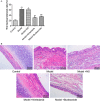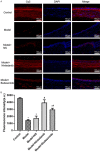Nintedanib ameliorates tracheal stenosis by activating HDAC2 and suppressing IL-8 and VEGF in rabbit
- PMID: 32913546
- PMCID: PMC7476127
Nintedanib ameliorates tracheal stenosis by activating HDAC2 and suppressing IL-8 and VEGF in rabbit
Abstract
Acquired tracheal stenosis is a common disease occurring after endotracheal intubation or tracheotomy. Currently, surgery is the main option to treat the stenosis. This study investigated therapeutic effect and possible mechanism of nintedanib on tracheal stenosis. The rabbit models of tracheal stenosis were established and were administered with nintedanib and budesonide. The damage and repair of the tracheal tissue were determined using hematoxylin and eosin (HE) staining. The expression of histone deacetylase 2 (HDAC2), interleukin-8 (IL-8) and vascular endothelial growth factor (VEGF) was detected by real-time quantitative reverse transcription polymerase chain reaction (qRT-PCR), Western Blot and immunofluorescence assay. The expression of collagens I and III was assayed immunohistochemically. Remarkable tracheal stenosis was observed after the trachea was brushed in the rabbit model. Compared with control, the stenosis was improved after nintedanib treatment. The mRNA of HDAC2 was increased and that of IL-8 and VEGF was decreased significantly in the tracheal tissue following nintedanib treatment. Western blot analysis showed that HDAC2 increased to the level similar to that of control while VEGF remained unchanged following nintedanib treatment. Budesonide treatment also resulted in increased HDAC2 expression and decreased IL-8 and VEGF expression. Immunofluorescence assays also showed an increased HDAC2 expression following nintedanib treatment. Collagens I and III decreased significantly after nintedanib treatment in the tracheal tissues of models. Therefore, it is concluded that nintedanib alleviates the acquired tracheal stenosis by activating HDAC2 expression and suppressing IL-8 and VEGF expression, and may offer new option to medical treatment for the disease.
Keywords: HDAC2; IL-8; Tracheal stenosis; VEGF; nintedanib.
AJTR Copyright © 2020.
Conflict of interest statement
None.
Figures





Similar articles
-
Expression of histone deacetylase 2 in tracheal stenosis models and its relationship with tracheal granulation tissue proliferation.Exp Ther Med. 2021 May;21(5):444. doi: 10.3892/etm.2021.9872. Epub 2021 Mar 1. Exp Ther Med. 2021. PMID: 33747180 Free PMC article.
-
Protective effects of different anti‑inflammatory drugs on tracheal stenosis following injury and potential mechanisms.Mol Med Rep. 2021 May;23(5):314. doi: 10.3892/mmr.2021.11953. Epub 2021 Jul 9. Mol Med Rep. 2021. PMID: 34240225 Free PMC article.
-
Role of Erythromycin-Regulated Histone Deacetylase-2 in Benign Tracheal Stenosis.Can Respir J. 2020 Jan 17;2020:4213807. doi: 10.1155/2020/4213807. eCollection 2020. Can Respir J. 2020. PMID: 32051729 Free PMC article.
-
[Effects of different drugs on bronchial stenosis by TGF-β/mTOR signaling pathway in rabbit model].Zhonghua Yi Xue Za Zhi. 2019 Jun 25;99(24):1898-1903. doi: 10.3760/cma.j.issn.0376-2491.2019.24.012. Zhonghua Yi Xue Za Zhi. 2019. PMID: 31269587 Chinese.
-
Anti-fibrosis activity of quercetin attenuates rabbit tracheal stenosis via the TGF-β/AKT/mTOR signaling pathway.Life Sci. 2020 Jun 1;250:117552. doi: 10.1016/j.lfs.2020.117552. Epub 2020 Mar 13. Life Sci. 2020. PMID: 32179074
Cited by
-
Drug delivery systems for wound healing treatment of upper airway injury.Expert Opin Drug Deliv. 2024 Apr;21(4):573-591. doi: 10.1080/17425247.2024.2340653. Epub 2024 Apr 10. Expert Opin Drug Deliv. 2024. PMID: 38588553 Free PMC article. Review.
-
Gene expression profiles in COVID-19-associated tracheal stenosis indicate persistent anti-viral response and dysregulated retinol metabolism.BMC Res Notes. 2024 May 16;17(1):140. doi: 10.1186/s13104-024-06775-y. BMC Res Notes. 2024. PMID: 38755665 Free PMC article.
-
Synergistic effects of silver nanoparticles and cisplatin in combating inflammation and hyperplasia of airway stents.Bioact Mater. 2021 Jul 29;9:266-280. doi: 10.1016/j.bioactmat.2021.07.029. eCollection 2022 Mar. Bioact Mater. 2021. PMID: 34820570 Free PMC article.
-
Long-Term Cigarette Smoke Exposure Promotes Neutrophil Ferroptosis Resistance, Inducing Neutrophil Extracellular Trap Formation and Driving Glucocorticoid Resistance in Chronic Obstructive Pulmonary Disease.Research (Wash D C). 2025 Jul 15;8:0751. doi: 10.34133/research.0751. eCollection 2025. Research (Wash D C). 2025. PMID: 40666830 Free PMC article.
-
Anti-inflammatory coupled anti-angiogenic airway stent effectively suppresses tracheal in-stents restenosis.J Nanobiotechnology. 2025 Jan 29;23(1):59. doi: 10.1186/s12951-024-03087-y. J Nanobiotechnology. 2025. PMID: 39881307 Free PMC article.
References
-
- Ressler B, Lee RT, Randell SH, Drazen JM, Kamm RD. Molecular responses of rat tracheal epithelial cells to transmembrane pressure. Am J Physiol Lung Cell Mol Physiol. 2000;278:L1264–1272. - PubMed
-
- Tschumperlin DJ, Shively JD, Kikuchi T, Drazen JM. Mechanical stress triggers selective release of fibrotic mediators from bronchial epithelium. Am J Respir Cell Mol Biol. 2003;28:142–149. - PubMed
-
- Hartmann S, Sid H, Rautenschlein S. Avian metapneumovirus infection of chicken and turkey tracheal organ cultures: comparison of virus-host interactions. Avian Pathol. 2015;44:480–489. - PubMed
-
- Squire R, Brodsky L, Rossman J. The role of infection in the pathogenesis of acquired tracheal stenosis. Laryngoscope. 1990;100:765–770. - PubMed
LinkOut - more resources
Full Text Sources
